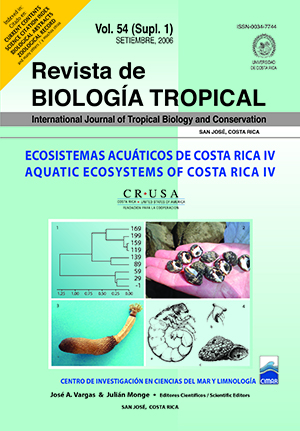Abstract
Fossil echinoderms from Costa Rica: preliminary notes. A preliminary list of the echinoderms fauna of Costa Rica from the Cenozoic is presented, based on the literature and from specimens from the fossil collection of the Central American School of Geology at the University of Costa Rica, the National Museum and personal collections. The fauna is composed by the class Crinoidea with only one genera and the class Echinoidea with seven orders, 18 families, 28 genera and 45 species. The Order Spatangoida is the most diverse of the six found, with seven families, 15 genera and 26 species. The most diverse family is Brissidae (8), whereas the diverse genus is Schizaster with seven species. Most of specimens belong to the Cretaceous and Miocene in a total of 11 geologic formations throughout all the country. In addition, a review of the scientific research of this group in Costa Rica from 1880 until today is presented. Rev. Biol. Trop. 54 (Suppl. 1): 287-299. Epub 2006 Sept. 30.References
Aguilar, T. 1978. Fauna de un perfil de la formación Terraba (Oligoceno, Costa Rica). Tesis de grado, Universidad de Costa Rica, San Pedro, Costa Rica. 84 p.
Aguilar, T. 1997. Parches arrecifales de Jesús María (Oligoceno-Mioceno Inferior): Una de las primeras comunidades del actual Caribe de Costa Rica. Tesis de Maestría, Universidad de Costa Rica, San Pedro, Costa Rica. 61 p.
Aguilar, T. 1999. Organismos de un arrecife fósil (Oligoceno Superior- Mioceno Inferior), del Caribe de Costa Rica. Rev. Biol. Trop. 47: 453-474.
Aguilar, T. 2000. Paleontología, p. 87-100. In P. Denyer & S. Kussmaul (eds.). Geología de Costa Rica. Tecnológica de Costa Rica, Costa Rica.
Aguilar, T. & J. Cortés. 2001. Arrecifes coralinos del Oligoceno Superior- Mioceno Inferior, de Turrialba, Costa Rica. Rev. Biol. Trop. 49: 203-213.
Alvarado, G. 1994. Historia Natural Antigua. Tecnológica de Costa Rica, Costa Rica. 232 p.
Astorga, A., J.A. Fernández, G. Barboza, L. Campos, J. Obando, A. Aguilar & L.G. Obando. 1991. Cuencas sedimentarias de Costa Rica: evolución geodinamica y potencial de hidrocarburos. Rev. Geol. Amer. Central 13: 25-59.
Buitrón, B.E. 1978. Distribución de los equinoideos terciarios en la planicie costera del Golfo de México, en América Central, en el norte de América del Sur y en la antillas. Univ. Nac. Aut. Mex. Inst. Geol. 101: 66-113.
Carballo, M.A. & R. Fischer. 1978. La formación San Miguel (Mioceno, Costa Rica). Inst. Geo. Nac., informe semestral, septiembre: 45-144.
Clarkson, E.N.K. 1998. Invertebrate Paleontology and Evolution. Blackwell Science, Inglaterra. 452 p.
Cortés, J. 1986. Biogeografía de corales hermatípicos: el istmo Centro Americano. An. Inst. Cienc. Mar y Limnol. U.N.A.M. 13: 297-304.
Cronin, T.M. & H.F. Dowsett. 1996. Biotic and oceanographic response to the Pliocene closing of the Central American Isthmus, p. 76-104. In J.B.C. Jackson, A.F. Budd & A.G. Coates (eds.). Evolution & Environment in Tropical America. Chicago, EEUU.
Denyer, P., G. Alvarado & T. Aguilar. 2000. Historia geológica, p. 155-167. In P. Denyer & S. Kussmaul (eds.). Geología de Costa Rica. Tecnológica de Costa Rica, Costa Rica.
Durham, J.W. 1961. Miocene echinoids from the Valle Central, Costa Rica. J. Paleontology. 35: 480-488.
Fernández, J.A., G. Botazzi, G. Barboza & A. Astorga. 1994. Tectonica y estratigrafía de la cuenca Limón sur. Rev. Geol. Amer. Central vol. especial Terremoto de Limón: 15-28.
Fischer, R. 1985. La fauna de la formación Turrúcares (Mioceno, Valle Central, Costa Rica). Geológica et Paleontológica. 19: 191-225.
Fischer, R. & T. Aguilar. 1994. Palaeontology of an evolving island arc. Profil 7: 391-400.
Gabb, W.M. 1881. Description of Caribbean Miocene fossils. J. Acad. Nat. Sci. Philadelphia 8: 337-348.
Hendler, G., J.E. Miller, D.L. Pawson & P.M. Kier. 1995. Sea Stars, Sea Urchins, and Allies. Echinoderms of Florida and the Caribbean. Smith. Inst., Washington, D.C. 390 p.
Hyman, L.H. 1955. The Invertebrates: Echinodermata. McGraw-Hill, Nueva York. 763 p.
Jaccard, S., M. Münster, P.O. Baumgartner, C. Baumgartner & P. Denyer. 2001. Barra Honda (Upper Paleocen-Lower Eocene) and El Viejo (Campanian-Mastrichtian) carbonate platforms in the Tempisque area (Guanacaste, Costa Rica). Rev. Geol. Am. Centr. 24: 9-28.
Jackson, R.T. 1917. Fossil echinoids of the Panama coastal zone and Costa Rica. U.S. Nat. Mus. Bull. 103: 103-116.
Kier, P.M. 1984. Fossil Spatangoid Echinoida of Cuba. Smith.Contrib. Paleontol. 55: 1-336.
Linkimer, L. & T. Aguilar. 2000. Estratigrafía sedimentaria, p. 43-62. In P. Denyer & S. Kussmaul (eds.). Geología de Costa Rica. Tecnológica de Costa Rica, Costa Rica.
Mooi, R. 1989. Living and fossil Genera of the Clypeasteroida (Echinoidea: Echinodermata): An illustrated key and annotated checklist. Smithsonian Contrib. Zool. 488: 1-51 p.
Ruppert, E.E. & R.D. Barnes. 1996. Zoología de los invertebrados. McGraw-Hill Interamericana, México. 1114 p.
Sanchez Roig, M. 1949. Los Equinodermos fósiles de Cuba. Paleontología Cubana I. O’Reilli Nº 304. 330 p.
Seyfried, H. & P. Sprechman. 1986. Über di Frühgeschichte (Campa bis Eozän) der südlichen mittelamerikanischen landbrücke. N. Jb. Geol. Paläont. Mh. 1: 38-55.
Vermeij, G.J. 1987. Evolution and Escalation: An ecological History of Life. Princeton Nueva Jersey. 527 p.
##plugins.facebook.comentarios##

This work is licensed under a Creative Commons Attribution 4.0 International License.
Copyright (c) 2006 Revista de Biología Tropical






